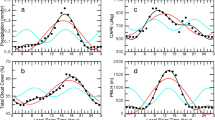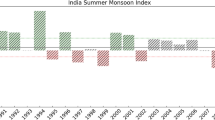Abstract
Clouds and precipitation simulated by climate models still have a large room for improvement. Geophysical Fluid Dynamics Laboratory (GFDL) High-Resolution Atmospheric Model (HiRAM) has much larger ice water path (IWP, ~ 5 times) and stratiform precipitation fraction (~ 10 times) than its Atmospheric Model version 2 (AM2) over the Tropics. It is found that such differences are mainly due to the replacement of the relaxed Arakawa Schubert (RAS) scheme in AM2 by the modified University of Washington (UW) shallow convection used in HiRAM. The focus of the study is to investigate the sensitivity of simulated cloud, precipitation, and radiation to the two key parameters (precipitation efficiency and entrainment specification) in RAS, and interpret the difference between AM2 and HiRAM. With more deep plumes inhibited, the convective heating and moistening decrease, and the upper troposphere becomes colder and drier. With reduced precipitation efficiency, more convective condensate is detrained and stratiform precipitation increases. Both precipitation efficiency and entrainment specification change the vertical heating profiles and precipitation partitioning, but via different mechanisms. Using offline radiation calculations, convection scheme-induced tropical radiation variation is investigated. Increased longwave trapping by increased upper level ice clouds is partially compensated by a dry and cold bias in the upper troposphere. However, top of atmosphere absorbed shortwave reduction is proportional to increased IWP, but the reduction is not as large as that computed using offline radiation calculation assuming similar increase of IWP. The reason is that the increased IWP associated with large-scale precipitation does not peak around noon with the maximum solar radiation as that associated with convective precipitation. The study highlights the importance of convective parameterization in regulating tropical clouds and radiation.








Similar content being viewed by others
References
Ackerman TP, Stokes GM (2003) The atmospheric radiation measurement program. Phys Today 56:38–45
Adler RF et al (2003) The Version-2 global precipitation climatology project (GPCP) monthly precipitation analysis (1979–present). J Hydrometeor 4:1147–1167
Anderson et al (2004) The new GFDL global atmosphere and land model AM2-LM2: evaluation with prescribed SST simulations. J Clim 17:4641–4673
Arakawa A (2004) The cumulus parameterization problem: past, present, and future. J Clim 17:2493–2525
Bechtold P, Köhler M, Jung T, Doblas-Reyes F, Leutbecher M, Rodwell M, Vitart F, Balsamo G (2008) Advances in simulating atmospheric variability with the ECMWF model: from synoptic to decadal time-scales. Q J R Meteorol Soc 134:1337–1351
Bretherton CS, McCaa JR, Grenier H (2004) A new parameterization for shallow cumulus convection and its application to marine subtropical cloud-topped boundary layers. Part I: description and 1D results. Mon Weather Rev 132:864–882
Chikira Minoru, Sugiyama Masahiro (2010) A cumulus parameterization with state-dependent entrainment rate. Part I: description and sensitivity to temperature and humidity profiles. J Atmos Sci 67:2171–2193
Clement AC, Soden B (2005) The sensitivity of the tropical-mean radiation budget. J Clim 18:3189–3203
Dai A (2006) Precipitation characteristics in eighteen coupled climate models. J Clim 19:4605–4630
de Rooy WC, Pier Siebesma A (2010) Analytical expressions for entrainment and detrainment in cumulus convection. Q J R Meteorol Soc 136:1216–1227. https://doi.org/10.1002/qj.640
Del Genio AD, Kovari W, Yao M-S, Jonas J (2005) Cumulus microphysics and climate sensitivity. J Clim 18:2376–2387
Donner LJ, Seman CJ, Hemler RS, Fan S (2001) A cumulus parameterization including mass fluxes, convective vertical velocities, and mesoscale effects: thermodynamic and hydrological aspects in a general circulation model. J Clim 14:3444–3463
Donner Leo J et al (2011) The dynamical core, physical parameterizations, and basic simulation characteristics of the atmospheric component AM3 of the GFDL global coupled model CM3. J Clim 24:3484–3519
Ehsan MA, Almazroui M, Yousef A (2017a) Impact of different cumulus parameterization schemes in SAUDI-KAU AGCM. Earth Syst Environ 1:3. https://doi.org/10.1007/s41748-017-0003-0
Ehsan MA, Almazroui M, Yousef A, Enda O, Tippett MK, Kucharski F, Alkhalaf AA (2017b) Sensitivity of AGCM-simulated regional JJAS precipitation to different convective parameterization schemes. Int J Climatol 37:4594–4609. https://doi.org/10.1002/joc.5108
Elsaesser Gregory S, Kummerow Christian D, L’Ecuyer Tristan S, Takayabu Yukari N, Shige Shoichi (2010) Observed self-similarity of precipitation regimes over the tropical oceans. J Clim 23:2686–2698
Emanuel KA, Zivkovic-Rothman M (1999) Development and evaluation of a convection scheme for use in climate models. J Atmos Sci 56:1766–1782
Fowler Laura D, Randall David A (2002) Interactions between cloud microphysics and cumulus convection in a general circulation model. J Atmos Sci 59:3074–3098
Fowler LD, Randall DA, Rutledge SA (1996) Liquid and ice cloud microphysics in the CSU general circulation model. Part I: model description and simulated microphysical processes. J Clim 9:489–529
Fu Q, Liou KN (1993) Parameterization of the radiative properties of cirrus clouds. J Atmos Sci 50:2008–2025
Held IM, Zhao M, Wyman B (2007) Dynamic radiative–convective equilibria using GCM column physics. J Atmos Sci 64:228–238
Houze RA Jr (2004) Mesoscale convective systems. Rev Geophys 42:43
Huffman GJ et al (2007) The TRMM multisatellite precipitation analysis (TMPA): Quasi-global, multiyear, combined-sensor precipitation estimates at fine scales. J Hydrometeor 8:38–55
Kikuchi K, Wang B (2008) Diurnal precipitation regimes in the global tropics. J Clim 21:2680–2696
Kiladis GN, Wheeler MC, Haertel PT, Straub KH, Roundy PE (2009) Convectively coupled equatorial waves. Rev Geophys 47:RG2003. https://doi.org/10.1029/2008rg000266
Klein SA, Zhang Y, Zelinka MD, Pincus R, Boyle J, Gleckler PJ (2013) Are climate model simulations of clouds improving? An evaluation using the ISCCP simulator. J Geophys Res Atmos 118:1329–1342. https://doi.org/10.1002/jgrd.50141
Kubar TL, Hartmann DL (2008) Vertical structure of tropical oceanic convective clouds and its relation to precipitation. Geophys Res Lett 35:L03804. https://doi.org/10.1029/2007GL032811
Kummerow C, Hong Y, Olson WS, Yang S, Adler RF, McCollum J, Ferraro R, Petty G, Shin DB, Wilheit TT (2001) The evolution of the Goddard profiling algorithm (GPROF) for rainfall estimation from passive microwave sensors. J Appl Meteor 40:1801–1840
Li J-LF et al (2012) An observationally based evaluation of cloud ice water in CMIP3 and CMIP5 GCMs and contemporary reanalyses using contemporary satellite data. J Geophys Res 117:D16105. https://doi.org/10.1029/2012JD017640
Lin J, Mapes BE, Zhang M, Newman M (2004) Stratiform precipitation, vertical heating profiles, and the Madden–Julian oscillation. J Atmos Sci 61:296–309
Lin Y, Donner LJ, Petch J, Bechtold P, Boyle J, Klein SA, Komori T, Wapler K, Willett M, Xie X, Zhao M, Xie S, McFarlane SA, Schumacher C (2012) TWP-ICE global atmospheric model intercomparison: convection responsiveness and resolution impact. J Geophys Res Atmos 117:D09111
Lin Y, Zhao Ming, Ming Yi, Golaz Jean-Christophe, Donner Leo J, Klein Stephen A, Ramaswamy V, Xie Shaocheng (2013) precipitation partitioning, tropical clouds, and intraseasonal variability in GFDL AM2. J Clim 26:5453–5466
Loeb NG, Wielicki BA, Doelling DR, Smith GL, Keyes DF, Kato S, Manalo-Smith N, Wong T (2009) Toward optimal closure of the Earth’s top-of-atmosphere radiation budget. J Clim 22:748–766
Moorthi S, Suarez MJ (1992) Relaxed Arakawa–Schubert: a parameterization of moist convection for general circulation models. Mon Weather Rev 120:978–1002
Park S, Bretherton CS, Rasch PJ (2014) Integrating cloud processes in the community atmosphere model, version 5. J Clim 27(18):6821–6856. https://doi.org/10.1175/JCLI-D-14-00087.1
Rotstayn LD (1997) A physically based scheme for the treatment of stratiform clouds and precipitation in large-scale models. I: description and evaluation of the microphysical processes. Q J R Meteorol Soc 123:1227–1282
Sanderson BM, Piani C, Ingram WJ, Stone DA, Allen MR (2008) Towards constraining climate sensitivity by linear analysis of feedback patterns in thousands of perturbed-physics GCM simulations. Clim Dyn 30:175–190
Shimpo Akihiko, Kanamitsu Masao, Iacobellis Sam F, Hong Song-You (2008) Comparison of four cloud schemes in simulating the seasonal mean field forced by the observed sea surface temperature. Mon Weather Rev 136:2557–2575
Simpson J, Wiggert V (1969) Models of precipitating cumulus towers. Mon Weather Rev 97:471–489
Slingo A (1989) A GCM parameterization for the shortwave radiative properties of water clouds. J Atmos Sci 46:1419–1427
Song X, Zhang GJ (2011) Microphysics parameterization for convective clouds in a global climate model: description and single-column model tests. J Geophys Res 116:D02201. https://doi.org/10.1029/2010JD014833
Tiedtke M (1993) Representation of clouds in large-scale models. Mon Weather Rev 121:3040–3061
Tokioka T, Yamazaki K, Kitoh A, Ose T (1988) The equatorial 30–60 day oscillation and the Arakawa-Schubert penetrative cumulus parameterization. J Meteor Soc Jpn 66:883–901
Waliser DE et al (2009) Cloud ice: a climate model challenge with signs and expectations of progress. J Geophys Res 114:D00A21. https://doi.org/10.1029/2008jd010015
Webb MJ, Senior C, Bony S, Morcrette J-J (2001) Combining ERBE and ISCCP data to assess clouds in the Hadley Centre, ECMWF, and LMD atmospheric climate models. Clim Dyn 17:905–922
Xie S et al (2010) Clouds and more: ARM climate modeling best estimate data. Bull Am Meteor Soc 91:13–20
Yang GY, Slingo J (2001) The diurnal cycle in the tropics. Mon Weather Rev 129:784–801
Zhang MH et al (2005) Comparing clouds and their seasonal variations in ten atmospheric general circulation models with satellite measurements. J Geophys Res 110:D15S02. https://doi.org/10.1029/2004jd005021
Zhao M (2014) An investigation of the connections among convection, clouds, and climate sensitivity in a global climate model. J Clim 27:5. https://doi.org/10.1175/jcli-d-13-00145.1
Zhao M, Held IM, Lin S-J, Vecchi GA (2009) Simulations of global hurricane climatology, interannual variability, and response to global warming using a 50-km resolution GCM. J Clim 22:6653–6678. https://doi.org/10.1175/2009JCLI3049.1
Zhao M, Golaz JC, Held IM, Ramaswamy V, Lin SJ, Ming Y, Ginoux P, Wyman B, Donner LJ, Paynter D, Guo H (2016) Uncertainty in model climate sensitivity traced to representations of cumulus precipitation microphysics. J Clim 1:1. https://doi.org/10.1175/jcli-d-15-0191.1
Acknowledgements
The author would like to thank Dr. Ming Zhao at GFDL for various discussions. This work was supported by Tsinghua University Initiative Scientific Research Program (2019Z07L01001).
Author information
Authors and Affiliations
Corresponding author
Rights and permissions
About this article
Cite this article
Lin, Y. Impact of Cumulus Microphysics and Entrainment Specification on Tropical Cloud and Radiation in GFDL AM2. Earth Syst Environ 3, 255–266 (2019). https://doi.org/10.1007/s41748-019-00099-9
Received:
Accepted:
Published:
Issue Date:
DOI: https://doi.org/10.1007/s41748-019-00099-9




